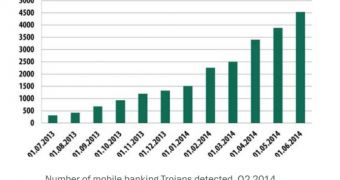A report from security firm Kaspersky reveals that the number of malicious files targeting banking information deployed on mobile devices in the second quarter of 2014 has almost doubled compared to the first quarter.
According to telemetry from the systems of the Russian-based security software developer, the number of this type of malware was 2,033 in Q2 2014, the grand total of malicious files recorded being 65,118.
Even if the overall figure seems impressive, Kaspersky says that it is 1.7 times lower than the detections registered in the first quarter of the year.
This may very well be due to the beginning of the holiday season, which even cybercriminals respect, since their systems recorded a reduction in attempts to compromise mobile devices using Trojans.
The upward trend in the mobile banking malware could be considered as a result of cybercriminals moving their business to the mobile world, as these devices continue to grow in popularity, or of their interest in methods designed to get larger amounts of money.
“From the beginning of 2014 the number of banking Trojans has increased by almost a factor of four, and over a year (from July 2012) - 14.5 times,” says the report.
At the top of the list of countries most attacked by mobile banking Trojans is Russia, accounting for 91.7% of the attacks, namely 13,800. This is a massive share, considering that all other countries, except for the runner up, the US (5.3% - 792 attacks), each recorded less than 1% of the total incidents.
As far as a breakdown of the most detected malware types goes, Kaspersky identified potentially unwanted advertising applications (27%) and SMS-Trojans (with 22%) on the top two positions. Coming on third was RiskTool, accounting for 18%.
Of all the threats identified by Kaspersky, Trojan-SMS.AndroidOS.Stealer.a. was the most frequently used, in 25% of all attacks. According to the company, the crooks were more active in April, with Stealer infection attempts being almost twice as frequent compared to May or March.
Many may assume that the numbers refer to Android devices, but Kaspersky informs that even if Google’s mobile OS was the main target of cybercriminals, with more than 99% of the threats being created for it, iOS was not left out; new malware objects popped up for Apple’s platform too, although they affected only jailbroken devices.
Moreover, with the exposure of Hacking Team, a company from Italy that produces legal spyware for various government agencies, malware for Windows Phone was also recorded.

 14 DAY TRIAL //
14 DAY TRIAL //